-
1 of 253523 objects
Jewel Cabinet 1787
Oak, mahogany, gilt bronze | 246.0 x 147.0 x 54.6 cm (whole object) | RCIN 31207
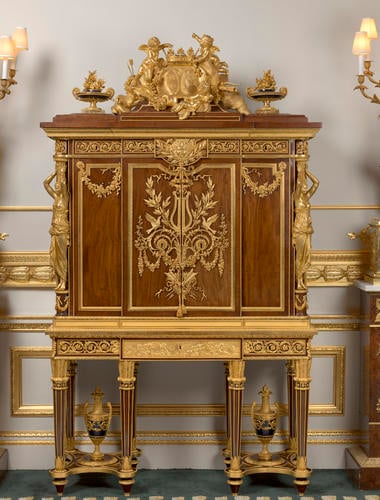

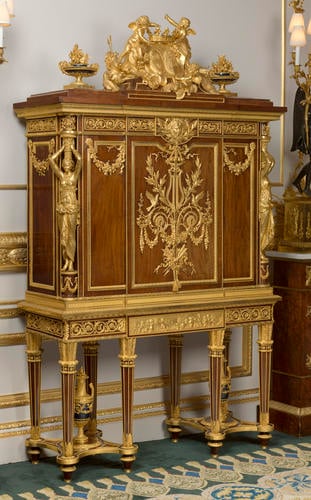
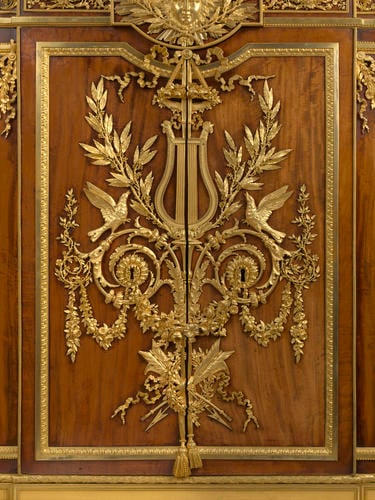
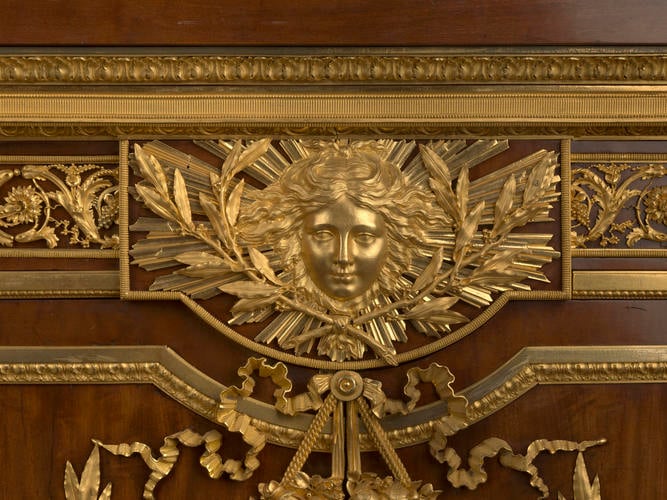
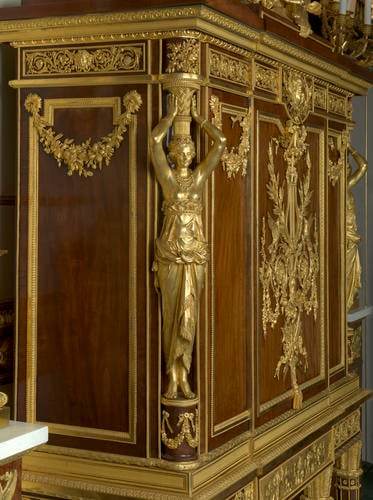
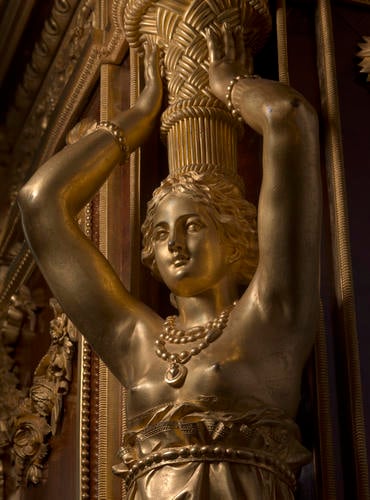
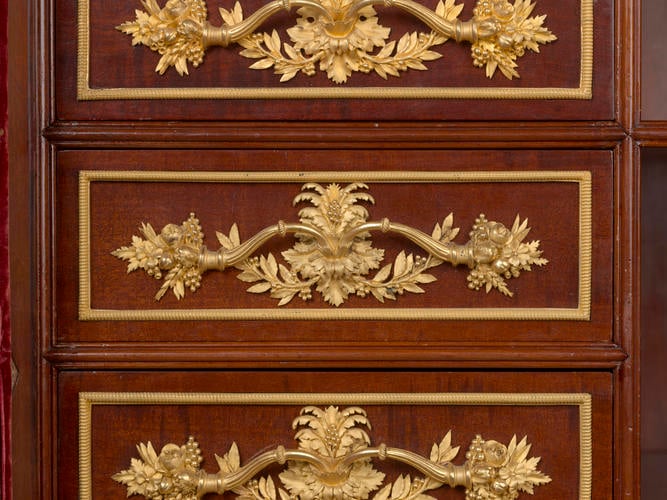
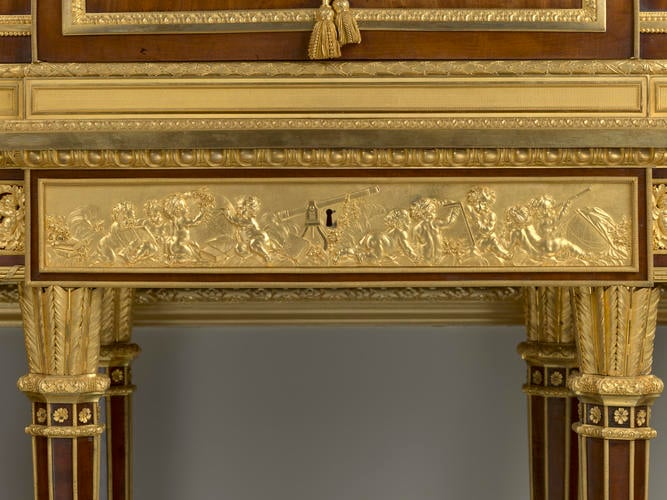

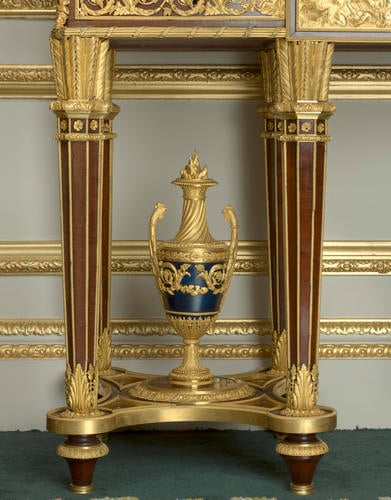
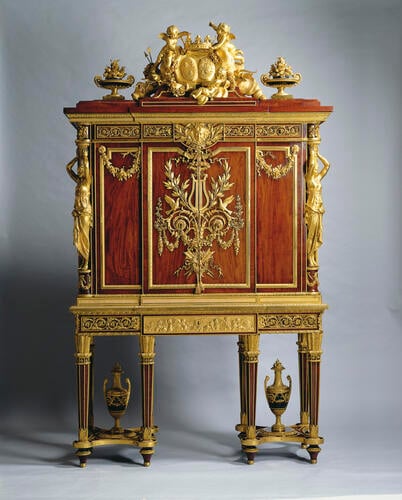

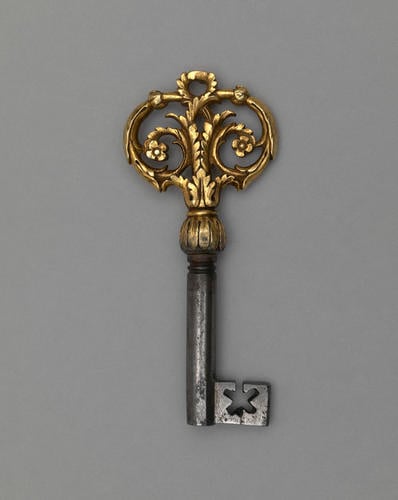
-
Mahogany and gilt bronze cabinet; superstructure with a group of putti holding a crown above conjoined coats-of-arms of the Bourbon and Savoy families flanked by vases. The frieze with three drawers; above two cabinet doors with scrolling foliage enclosing two doves, the front angles with sentinel female figures, the doors enclosing eighteen drawers and three open shelves (perhaps originally to hold coffres-forts (strong boxes) for jewellery, the stand with a drawer and a panel depicting putti among astronomical instruments, on eight legs formed as arrows in a quiver, with two vases on x-frame stretchers within each quartet of legs.
Stamped J.H. RIESENER
Long regarded as one of the greatest masterpieces of furniture made during the reign of Louis XVI, this remarkably lavish jewel cabinet combines cabinet-making virtuosity of a high order with exceptional gilt bronze mounts. The well-figured, plain mahogany veneers, characteristic of Riesener's output in the later 1780s reflecting the fashion of the time for using plain mahogany instead of elaborate marquetry veneers, provide a deliberate foil to the jewel-like mounts.Christian Baulez has recently suggested that the bronzes on the cabinet may have been made by the leading Parisian gilt bronze founder, Etienne Martincourt.
Although signed or stamped by Riesener, the cabinet bears no French royal inventory number. However, the prominent coat of arms identifies the first owner as Marie-Joséphine-Louise of Savoy, who married Louis XVI's younger brother, the Comte de Provence (the future Louis XVIII), in 1771. Until the Dauphin, the comte de Provence's nephew, came of age in 1787, the Provences had lived in a ground floor apartment of Versailles - directly below the King's State Apartment. However, in 1787 Louis XVI gave permission for the Dauphin to move into that apartment causing the Provences to move to the Aile du Midi, or South Wing of the Palace. It was for this new apartment that Riesener supplied this piece.
In 1784, following the arrival of Thierry de Ville d'Avray as Intendant of the Garde Meuble, Riesener had been removed fromhis official position as ébéniste ordinaire du garde meuble, to be replaced by the cheaper and less talented Guillaume Benneman. Although Riesener's workshop in fact continued to supply the court through Benneman's workshop, he could no longer claim a direct and official link to the greatest of commssions. However, he continued to receive orders from Queen Marie-Antoinette who adored his furniture. He also received commissions from the comte and comtesse de Provence, including this cabinet. In the same year, 1787, Marie Antoinette took delivery of a new and strikingly modern design of jewel cabinet, designed by Jean Démosthène Dugourc and made by Ferdinand Schwerdfeger (Versailles, OA 5515). Both the Queen and the comtesse had enjoyed older jewellery cabinets up until this point, neither of whiuch survive, the Queen's former cabinet was made in 1770 (when she was dauphine) by Maurice Bernard Ewald (known as Evalde), while comtesse de Provence was delivered a similar jewel cabinet designed by the dealer Claude Delaroue in 1771, the year of her marriage. These coeval commissions of spectacular jewel cabinets may have been exercises in lavish expenditure, virtuoso craftsmanship and undeliable sumptuousness, but may also have been given to show to leadership in royal patronage and taste. Since the reign of Louis XIV, such considerations were never far from French royal furnishing projects.
The subsequent history of the cabinet provides a fascinating commentary on changing tastes and past political associations of furnishings. By 1791 it had moved from Versailles to the Provences apartmet in the Palace of the Petit-Luxembourg, and confiscated with the rest of the Provence property after they had fled into exile in 1794. The follwoing year it was recommended by Citizen Bayard for display in a national museum, however, it was sold in October 1796. In 1809 it was offered to the imperial household for 30,000 francs by the then owner, who was said to have paid over 60,000 francs for it. Instead Naproleon ordered a jewel cabinet in up-to-the-minute fashion, made by François-Honoré-Georges Jacob-Desmalter, for his wife Josephine's bedroom at the Tuileries. Napoleon was offered the cabinet again in 1811 when his Intendant général responded: 'S.M. veut faire du neuf et non acheter du vieux'. In 1812 Napoleon ordered two more, smaller jewel cabinets for his second wife, Marie-Louise, for less than half the price of purchasing the Riesener cabinet of 1787.
George IV had no such inhibitions when it came up for sale in the Watson Taylor collection; he purchased it for 400 guineas with the intention of using it at Windsor Castle, although it was never allocated a particular space there during Geoirge IV's lifetime, his refurnishing project cut short by his death in 1830. In 1853 it was displayed in the exhibiiton Specimens of Cabinet Work at Gore House, and it excited such interest, Queen Victoria allowed the fourth Marquess of Hertford to have a copy made. Executed by John Webb in 1855-7, it cost the enormous sum of £2,500. It was also loaned to the Art Treasures Exhibition held in Manchester in 1857.
In the later 19th century, the name of Riesener was often conflated with that of the great Parisian 18th century bronzier Pierre Gouthière. The cabinet was illustrated in an album of watercolours by William Gibb (1839-1929) of great objects in the Royal Collection where it was described as The Gouthier Cabinet (929386). The album was presented to Queen Mary in 1935.Provenance
Made for the comtesse de Provence, 1787; confiscated 1794; sold 1796 (probably to Villemain); Charles François Guesnier and his wife, Femme Aulmont, by 1809; George Watson Taylor; his sale, Christie's, London, 28 May 1825 lot 76, bought by Joseph Fogg for George IV (£420).
-
Creator(s)
(cabinet maker)(nationality)Acquirer(s)
-
Medium and techniques
Oak, mahogany, gilt bronze
Measurements
246.0 x 147.0 x 54.6 cm (whole object)
Category
Object type(s)
Other number(s)
Laking FR : Laking, G.F., 1905. The Furniture of Windsor Castle, London – Laking FR p147,pl.45Alternative title(s)
Riesener Jewel Cabinet
Comtesse de Provence Cabinet